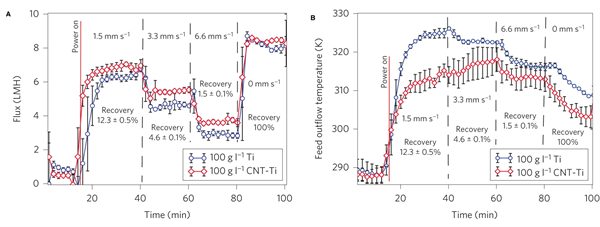Conductive Thin-Films For Direct Membrane Surface Electroheating
Patent Status
| Country | Type | Number | Dated | Case |
| United States Of America | Issued Patent | 10,654,001 | 05/19/2020 | 2016-434 |
Full Description
Background
Membrane Distillation (MD) is the treatment method of choice for desalination due to their relative insensitivity to salinity. Hot high-salinity brines are highly corrosive, which makes heat management in these systems, expensive due to the need for corrosion resistant metals. A porous and electrically conducting Carbon Nanotube (CNT) film deposited on the membrane surface, in direct contact with the brine, could be used as a Joule heater to drive the MD desalination process. Although, CNT based Joule heaters have been demonstrated they have either been (a) used in non-ionizable medium or (b) direct current was used to provide the energy. Large electric potentials needed can lead to rapid electrochemical degradation of the CNT films in an ionizable medium due to the formation of electrical double layer (EDL).
Current Invention
Researchers at UCR, led by Prof. David Jassby, have developed a patented technology, a porous, thin film, CNT Joule heater that demonstrate stable operation in highly ionizable environment. The CNT film is made by a layer-by-layer spray coating of carboxylated CNTs and polyvinyl alchohol (PVA) onto a polyvinyl tetrafluoroethylene (PTFE) membranes. The result is a highly conductive, hydrophilic, porous thin film deposited on a hydrophobic porous membrane support. The use of Alternating Current in their development allows for control of the EDL due to the rapid switching of polarity.

Permeate flux and feed outflow temperature data for different cross-flow velocities with a brine concentration of 100 g l–1 NaCl.
Advantages
The novel aspects of their invention are:
Suggested uses
- Water treatment
- Membrane distillation
- Pervaporation
- Gas separation
- Brine extraction
- Desalination
Related Materials
Inventions by Prof. David Jassby
Please see all inventions by Prof. David Jassby and his team at UCR
Contact
- Venkata S. Krishnamurty
- venkata.krishnamurty@ucr.edu
- tel: View Phone Number.
Other Information
Keywords
Membrane distillation, Water treatment, Pervaporation, Gas separation, Brine extraction, Desalination
